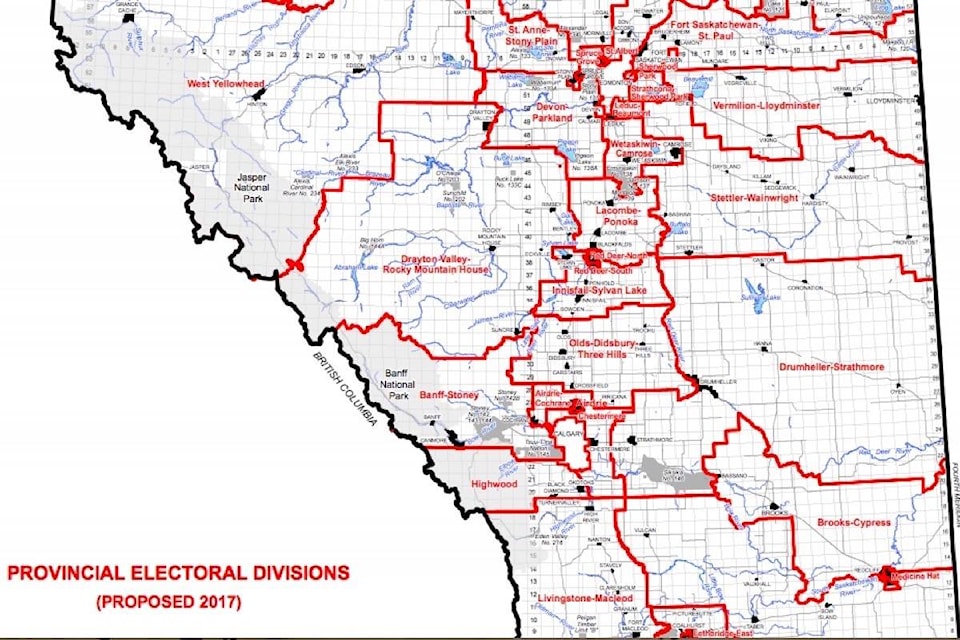The interim report on Alberta electoral boundaries recommends reducing the number of rural ridings and increasing the number of urban ridings.
The Alberta Electoral Boundaries Commission released the 200-page report on proposed new boundaries and names earlier this week. A final report to the government is expected by Oct. 31.
Included in the recommendations is that the five constituencies of of Rimbey-Rocky Mountain House-Sundre, West Yellowhead, Drayton Valley-Devon, Whitecourt-Ste. Anne and Stony Plain be “blended” to become four.
The seven ridings of Battle River-Wainwright, Drumheller-Stettler, Strathmore-Brooks, Little Bow, Cardston-Taber-Warner, Cypress-Medicine Hat and Vermilion-Lloydminister should be made into six, the majority of members said.
The four constituencies of Lac La Biche-St. Paul-Two Hills, Athabasca-Sturgeon-Redwater, Fort Saskatchewan-Vegreville and Bonnyville-Cold Lake are proposed to become three.
The five-member commission is required to maintain the same number of ridings in Alberta — 87 — while adjusting boundaries based on population and other factors. There are 87 ridings.
The population of a proposed electoral division must not be more than 25 per cent above, nor more than 25 per cent below, the average population of all proposed electoral divisions.
The recommendations would have little impact on Red Deer.
To deal with increased population, the commission’s majority recommendation is that there to be one more riding each in Calgary and Edmonton, and another one north of Calgary. They would be called Edmonton-South, Calgary-Northeast and Airdrie-Cochrane.
Commission member Gwen Day’s minority opinion recommends that electoral boundaries be set in each of Calgary and Edmonton so that no additional electoral divisions would be required to be added in either city. “That would result in most or all of the electoral divisions in each city containing populations above provincial average population size but below the 25 per cent maximum size permitted under the Act. As a result, no amalgamation of electoral divisions outside of these cities would be required.”
The populations of Red Deer-North and Red Deer-South electoral divisions are relatively equal, and the majority recommendation is to move the boundary within the city to reunite the Deer Park community with Red Deer-South.
The result is the population of Red Deer-North would be two per cent above the electoral division provincial average, and the population of Red Deer-South 13 per cent above the provincial average.
Drayton Valley-Rocky Mountain House would have a population 17 per cent above the average. The commission recommends it be created from current electoral division of Rimbey-Rocky Mountain House-Sundre and parts of Drayton Valley-Devon. The northern boundary of the current Rimbey Rocky Mountain House-Sundre should extend further north to capture Drayton Valley, up to the southern boundary of the current Whitecourt-Ste. Anne constituency, not including Pigeon Lake.
The commission recommends that for Lacombe-Ponoka, the Maskwacis reserves located along the northern border of the constituency be moved into the constituency of Wetaskiwin-Camrose. This avoids the need to create a blended riding with the city of Red Deer. It continues to use the Red Deer River as the southwest border of the constituency.
The Wildrose Party does not support the interim report as it stands because it places too much emphasis on population numbers.
Olds-Didsbury-Three Hills MLA Nathan Cooper said Friday that he hopes the commission will heed Day’s warning that it does not provide effective representation for all Albertans.
“We see significant challenges around moving three rural ridings and feel that the commission has placed too large of an emphasis on population and not on other aspects of the legislation that allows for effective representation (in rural Alberta).”
He points to how a rural MLA has many more municipalities, school boards and elected officials to deal with than their urban counterparts.
There are real concerns around whether the interim commission go it right, he said.
Albertans can submit feedback on the Interim Report recommendations until July 8. Public hearings will be held between July 17 and 21 in Grande Prairie, Vermilion, Edmonton, Calgary and Brooks. The commission has received 749 submissions and comments from hundreds of people who attended earlier public hearings across the province, including in Red Deer.
To read the full report online, go to abebc.ca
